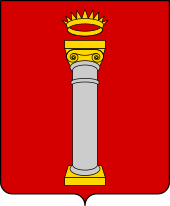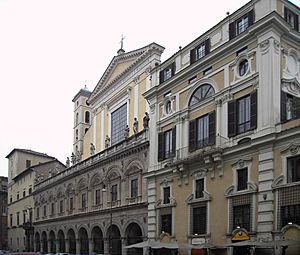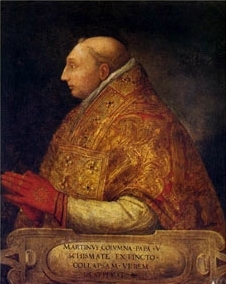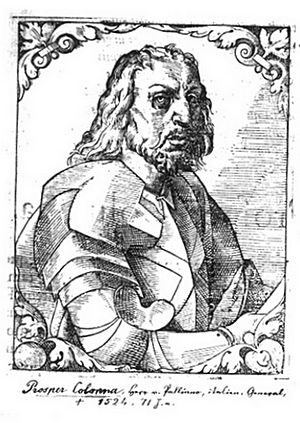Colonna family facts for kids
Quick facts for kids Colonna |
|
|---|---|
| Black noble family | |
 |
|
| Parent family | Counts of Tusculum |
| Country | |
| Current region | |
| Etymology | "Column", from Trajan's Column or city of Colonna |
| Place of origin | Tusculum, Alban Hills |
| Founded | 1101 |
| Founder | Patrus de Columna |
| Current head | Federico Colonna (Paliano line) Mirta Barberini-Colonna (Carbognano line) |
| Titles |
List
Pope (non-hereditary)
Prince assistant to the Papal throne (1514–present) Prince of Paliano (1556–present) Prince of Stigliano (1796–present) Prince of Sonnino (1503–1796) Prince of Carbognano (1630–present) Prince of Salerno (1419–1432) Prince of Gallicano (13th century–1870) Prince of Palestrina (12th century–1630) Roman Patrician (1101–1870) |
| Motto |
Mole sua stat
(It stands by its own stature) |
| Estate(s) | Palazzo Colonna (seat) Orsini-Colonna Castle (1546–1806) |
The House of Colonna is a very old and powerful Italian noble family. They were a big part of the papal nobility, which means they were important families connected to the Pope and the Catholic Church. The Colonna family was super influential in Rome during the Middle Ages and the Renaissance. They even had one of their own become a Pope, Pope Martin V.
The Colonna family was famous for a long and bitter fight with another powerful family, the Orsini family. They both wanted more power in Rome. This rivalry finally ended in 1511 thanks to a special order from the Pope called a papal bull. Later, in 1571, the leaders of both families even married nieces of Pope Sixtus V, which helped bring lasting peace between them.
Contents
History of the Colonna Family
How the Colonna Family Started
The Colonna family is believed to have come from the Counts of Tusculum. A man named Peter, who lived from 1099 to 1151, was called Peter "de Columna." This name came from his castle, Columna Castle, in a town called Colonna, Lazio. This town is in the Alban Hills near Rome.
The family's name, "Colonna," means "column." It might refer to Trajan's Column in Rome or the town of Colonna itself.
The first member of the family to become a cardinal (a high-ranking church official) was Giovanni Colonna di Carbognano in 1206.
A special person from the family was Margherita Colonna, who died in 1248. She was part of the Franciscan religious order and was later recognized as a blessed person by the Church.
The Colonna and Orsini Rivalry
Around this time, a big rivalry started between the Colonna family and the Orsini family. The Orsini family supported the Pope, making them part of the Guelph group. The Colonna family, however, often supported the Holy Roman Emperor, making them part of the Ghibelline group. This meant they were often on opposite sides during conflicts between the Pope and the Emperor.
Fighting the Pope
In 1297, a cardinal named Jacopo Colonna had a disagreement with his brothers over land. His brothers asked Pope Boniface VIII for help. The Pope told Jacopo to give back the land and even hand over some family castles to the Church. Jacopo refused. Because of this, Pope Boniface VIII removed Jacopo from his cardinal position and banned him and his supporters from the Church.
The Colonna family, except for the brothers who sided with the Pope, said that Boniface VIII was not a real Pope. This led to a war. By 1298, the Pope's army destroyed the Colonna family's main towns. The rest of the family had to leave Italy.
The exiled Colonnas teamed up with King Philip IV of France, who was also an enemy of the Pope. In 1303, a Colonna family member named Sciarra and the King's advisor tried to arrest Pope Boniface VIII in a town called Anagni. This event is known as the "Outrage of Anagni." They managed to capture the Pope for a short time, and Sciarra reportedly slapped him. Locals soon freed the Pope, but he died shortly after. This event weakened the Pope's power and allowed France to have more influence over future Popes.
Important Times in the Late Middle Ages
The Colonna family continued to be important in both government and church matters. Cardinal Egidio Colonna, who died in 1314, was a very smart thinker of his time. He had studied with the famous St. Thomas of Aquinas.
In the 14th century, the family helped decorate the Church of San Giovanni in Rome, especially its beautiful floor mosaics.
In 1328, when Louis IV of Germany came to Italy to be crowned Emperor, the Pope was not in Rome. So, Louis asked a Roman noble to crown him. Sciarra Colonna was chosen for this honor. Because of this, the Colonna family was allowed to use an imperial crown on their family crest.
The famous poet Petrarch was a close friend of the Colonna family. He often stayed with them in Rome and wrote poems for their special events.

The Colonna family finally achieved their dream of having a Pope from their family at the Council of Constance. Oddone Colonna was elected Pope Martin V on November 14, 1417. He was Pope until his death in 1431.
The Early Modern Period
Vittoria Colonna became a famous poet in the 1500s. She was well-known in educated circles and was a friend of the famous artist Michelangelo.
In 1627, Anna Colonna married Taddeo Barberini, whose uncle was Pope Urban VIII. This marriage connected the Colonna family to another powerful papal family, the Barberini. Later, in 1728, a branch of the Colonna family even added the Barberini name to theirs.
The Colonna Family Today
The Colonna family still holds an important role today. They have been "Prince Assistants to the Papal Throne" since 1710. This is a special title given to noble families who help the Pope.
The family's main home in Rome, the Palazzo Colonna, is a beautiful palace that is open to the public on Saturday mornings.
The main branch of the family, called 'Colonna di Paliano', is currently led by Prince Marcantonio Colonna di Paliano.
Famous Colonna Family Members
Many members of the Colonna family have been important figures throughout history:
- Blessed Margherita Colonna (around 1255 – 1280): A holy woman from the Franciscan order.
- Stefano Colonna (1265 – around 1348): An important noble in Rome during the Middle Ages.
- Jacopo Colonna (1250 – 1318): A cardinal involved in conflicts with the Pope.
- Giovanni Colonna (1295–1348): An influential cardinal during the time when Popes lived in Avignon, France.
- Oddone Colonna (1369–1431): He became Pope Martin V in 1417, which helped end a big split in the Catholic Church.

- Ludovico Colonna (1390-1436): A condottiero, which means a military leader for hire.
- Fabrizio Colonna (around 1450 – 1520): A general who fought in important wars. He was the father of Vittoria Colonna.
- Prospero Colonna (1452–1523): Another military leader who fought alongside his cousin Fabrizio.
- Marcantonio II Colonna (1535–1584): A Duke who fought in the famous naval Battle of Lepanto against the Turks in 1571. He also served as a Viceroy (a ruler representing the King) of Sicily.
- Vittoria Colonna (1490–1547): A famous poet and a friend of the artist Michelangelo.
- Guido Colonna di Paliano (1908–1982): A diplomat and an important figure in the European Union.
See also
 In Spanish: Familia Colonna para niños
In Spanish: Familia Colonna para niños
- Medieval Rome
- Orsini family
- Palestrina


